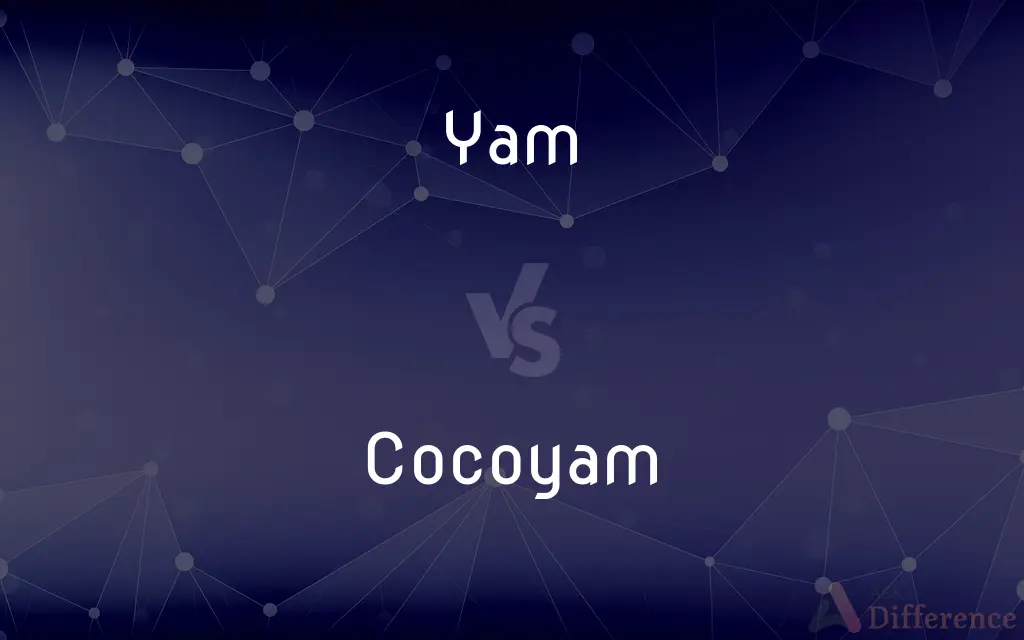Yam vs. Cocoyam — What's the Difference?
By Fiza Rafique & Urooj Arif — Updated on March 1, 2024
Yam is a starchy tuber with a rough skin and white flesh, widely consumed in Africa and Asia, known for its versatility in dishes. Cocoyam, or taro, has softer skin, typically purple flecks, and is used both for its leaves and tubers in various cuisines.

Difference Between Yam and Cocoyam
Table of Contents
ADVERTISEMENT
Key Differences
Yams are a significant staple food in many parts of Africa, Asia, and the Caribbean, characterized by their cylindrical shape, rough, bark-like skin, and white or sometimes yellow or purple flesh. They are known for their high carbohydrate content and are often boiled, roasted, or fried. Cocoyam, also known as taro, is smaller, with a more fibrous and softer skin often spotted with purple. Its flesh can be white, pink, or purple and is commonly used in soups, stews, or as a steamed vegetable, appreciated for its nutty flavor.
The cultivation of yams is more labor-intensive, requiring mounds or ridges to support their growth, and they have a longer growing season compared to cocoyams. Cocoyams, being more shade-tolerant, can be grown under or alongside other crops, making them a preferred choice for mixed cropping systems.
Both yams and cocoyams are rich in carbohydrates, fiber, and essential nutrients, but cocoyams have a higher content of dietary fiber and vitamins, especially vitamin E and C, compared to yams. This makes cocoyams slightly more beneficial for digestive health and antioxidant properties.
Yams are often used in more diverse ways due to their varying sizes and types. They can be found in traditional dishes ranging from simple boiled yams to complex preparations like pounded yam, which is served with various soups and stews. Cocoyams are not only valued for their tubers but also for their leaves, which are widely used in dishes like Laing and Callaloo, offering a unique texture and flavor profile.
Both yams and cocoyams are integral to the diets of many cultures around the world, their cultivation, nutritional content, and culinary uses display distinct characteristics that reflect their diversity and versatility in global cuisines.
ADVERTISEMENT
Comparison Chart
Skin Texture
Rough and bark-like.
Softer with purple specks.
Flesh Color
White, can be yellow or purple.
White, pink, or purple.
Cultivation
Requires mounds/ridges, labor-intensive, longer season.
Shade-tolerant, suitable for mixed cropping, shorter season.
Nutritional Value
High in carbohydrates; lower in dietary fiber and vitamins.
Higher in dietary fiber, vitamin E, and C.
Culinary Uses
Boiled, roasted, fried; used in diverse dishes.
Tubers and leaves used in soups, stews, and as vegetables.
Flavor
Varies but generally starchy and bland.
Nutty flavor.
Leaf Usage
Not commonly used.
Leaves are widely used in cooking.
Compare with Definitions
Yam
Not leafy.
Unlike cocoyam, yam cultivation focuses solely on the tuber.
Cocoyam
Rich in dietary fiber and vitamins.
Cocoyam adds nutritional value to the diet with its high vitamin content.
Yam
High carbohydrate content.
Yams provide the energy needed for daily activities in many cultures.
Cocoyam
A tuber with a softer, purple-flecked skin.
Cocoyam is a key ingredient in the Filipino dish, Laing.
Yam
Different varieties.
The white yam is preferred for its sweet taste.
Cocoyam
Used for its leaves and tubers.
Cocoyam leaves are used in making the Caribbean dish, Callaloo.
Yam
A starchy tuber with a rough skin.
Yams are a staple in Nigerian cuisine, often served as pounded yam.
Cocoyam
Requires less intensive cultivation.
Cocoyam grows well in shaded areas, making it easy to cultivate.
Yam
Versatile in cooking.
Fried yam slices are a popular snack in Ghana.
Cocoyam
Tropical starchy tuberous root
Yam
Any of numerous chiefly tropical vines of the genus Dioscorea, many of which have edible tuberous roots.
Cocoyam
Nutty flavor.
The nutty taste of cocoyam enriches the flavors of soups and stews.
Yam
The starchy root of any of these plants, used in the tropics as food.
Cocoyam
Cocoyam is a common name for more than one tropical root crop and vegetable crop belonging to the Arum family (also known as Aroids and by the family name Araceae) and may refer to: Taro (Colocasia esculenta) - old cocoyam Malanga (Xanthosoma spp.) - new cocoyamCocoyams are herbaceous perennial plants belonging to the family Araceae and are grown primarily for their edible roots, although all parts of the plant are edible. Cocoyams that are cultivated as food crops belong to either the genus Colocasia or the genus Xanthosoma and are generally composed of a large spherical corm (swollen underground storage stem), from which a few large leaves emerge.
Yam
A large, esculent, farinaceous tuber of various climbing plants of the genus Dioscorea; also, the plants themselves. Mostly natives of warm climates. The plants have netted-veined, petioled leaves, and pods with three broad wings. The commonest species is Dioscorea sativa, but several others are cultivated.
Cocoyam
Edible starchy tuberous root of taro plants
Yam
Edible tuber of any of several yams
Yam
Edible tuberous root of various yam plants of the genus Dioscorea grown in the tropics world-wide for food
Common Curiosities
Which is healthier, yam or cocoyam?
Both are healthy, but cocoyams have a higher content of dietary fiber and vitamins, making them slightly more beneficial for digestive health and antioxidant properties.
Are yams and cocoyams the same as sweet potatoes?
No, yams and cocoyams are botanically different from sweet potatoes, each with unique characteristics and culinary uses.
What is the main difference between yam and cocoyam?
The main difference lies in their skin texture, culinary uses, and the part of the plant used, with yams having rough skin and mainly used for their tubers, while cocoyams have softer skin and utilize both tubers and leaves.
Can you substitute yam for cocoyam in recipes?
While you can substitute them based on the dish's texture and flavor profile needs, they have distinct tastes and uses in cooking.
What does cocoyam taste like?
Cocoyam has a nutty flavor, which is distinct from the more bland and starchy taste of yams.
Can yam and cocoyam be grown together?
While both require different cultivation conditions, cocoyams, being shade-tolerant, can sometimes be grown alongside other crops, unlike yams which require more specific conditions.
Is cocoyam good for weight loss?
Due to its high fiber content, cocoyam can be beneficial for weight loss as part of a balanced diet by helping to keep you fuller for longer.
Why are cocoyam leaves used in cooking?
Cocoyam leaves are used for their nutritional value and unique flavor they add to dishes, unlike yam leaves which are not commonly consumed.
How do you cook yams?
Yams can be boiled, roasted, fried, or pounded and are used in a wide range of dishes from simple to complex preparations.
How long does it take to grow yams?
Yams have a longer growing season, typically requiring six to ten months to mature, depending on the variety.
Can I eat yam skin?
Yam skin is usually not eaten due to its rough texture; it's typically peeled off before cooking.
What are the benefits of eating cocoyam?
Cocoyam is beneficial for its high dietary fiber, vitamin E, and C content, supporting digestive health and providing antioxidant properties.
Are there different types of yams?
Yes, there are many varieties of yams, each with unique characteristics, including differences in size, taste, and color.
How do you store yams and cocoyams?
Both should be stored in a cool, dark, and well-ventilated place to prolong their shelf life.
What's the best way to cook cocoyam leaves?
Cocoyam leaves are best cooked by steaming or boiling to reduce potential irritation from oxalates and to preserve their nutritional value and flavor.
Share Your Discovery

Previous Comparison
Build vs. Raise
Next Comparison
Writ vs. SubpoenaAuthor Spotlight
Written by
Fiza RafiqueFiza Rafique is a skilled content writer at AskDifference.com, where she meticulously refines and enhances written pieces. Drawing from her vast editorial expertise, Fiza ensures clarity, accuracy, and precision in every article. Passionate about language, she continually seeks to elevate the quality of content for readers worldwide.
Co-written by
Urooj ArifUrooj is a skilled content writer at Ask Difference, known for her exceptional ability to simplify complex topics into engaging and informative content. With a passion for research and a flair for clear, concise writing, she consistently delivers articles that resonate with our diverse audience.















































